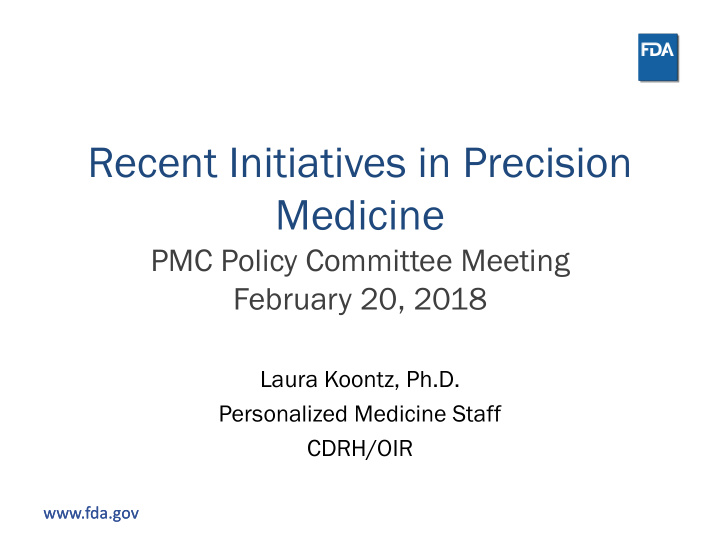



Recent Initiatives in Precision Medicine PMC Policy Committee Meeting February 20, 2018 Laura Koontz, Ph.D. Personalized Medicine Staff CDRH/OIR www.fda.gov www.fda.gov
Agenda • Oncopanels • 2018 Priorities in Precision Medicine – NGS Guidances – Codevelopment Guidance – Investigational IVDs • CDRH Strategic Priorities www.fda.gov
Oncopanels • 3 key authorizations in 2017 – ThermoFisher’s OncoMine Target Test Dx • Lung cancer panel • 3 CDx claims • 23 genes – MSK-IMPACT • Solid tumor panel • 468 genes + MSI • De Novo set up Class II pathway, potential 3 rd party review – Foundation Medicine’s F1CDx • Solid tumor panel • 15 CDx claims in 5 cancer types • 324 genes + MSI, TMB www.fda.gov
Three Tiered Approach for Reporting Biomarkers in Oncopanels Level 1 companion diagnostics: AV for each biomarker; CV established by clinical study or CDx clinical concordance with a previous CDx EVIDENCE Level 2 biomarkers: AV either per biomarker or Cancer Mutations representative; CV established in professional with Evidence of guidelines, but NOT demonstrated with the test. Clinical Significance Level 3 biomarkers: AV by representative approach; CV validity not demonstrated either in Cancer Mutations with professional guidelines or with the test, but Potential Clinical suggestive based on clinical/biological evidence. Significance www.fda.gov
A Fluid Approach to Reporting within Levels 2 and 3 • Clinical evidence regarding mutations accumulates rapidly CDx and may differ based on tumor type. Cancer Mutations with Evidence of • Test developers need flexibility in Clinical Significance how they report mutations. • As clinical evidence develops, Cancer Mutations with can move mutations from level 3 Potential Clinical Significance to level 2 provided the AV of the test reviewed and established via a submission www.fda.gov
Pathways for FDA Clearance or Approval Premarket Application (FDA): • Appropriate for oncopanels with companion o diagnostic claims CDx Can also make Level 2/3 claims o 510(k) Pathway (FDA or 3 rd Party): • Cancer Mutations For tumor profiling tests making Level 2/3 claims only o with Evidence of Can choose to submit 510(k) to FDA directly or elect Clinical o to use an accredited FDA third-party reviewer (e.g., Significance NYSDOH) Test developers that want to submit their oncopanels o Cancer Mutations with for federal clearance through NYSDOH can request to Potential Clinical have their NYSDOH package and review memo Significance forwarded along to FDA For 3 rd party review, FDA has 30 days to make a o determination follow receipt of package For direct submission, FDA has 90 days to make o determination www.fda.gov
2018 Priorities in PM Finalization of NGS Guidances • July 2016 – Two draft guidances published: – “Use of Public Human Genetic Variant Databases to Support Clinical Validity for Next Generation Sequencing (NGS)-Based In Vitro Diagnostics” – “Use of Standards in FDA Regulatory Oversight of Next Generation Sequencing (NGS)-Based In Vitro Diagnostics (IVDs) Used for Diagnosing Germline Diseases” www.fda.gov
2018 Priorities in PM Finalization of NGS Guidances Database Guidance overview: • Scope: publicly accessible databases of genetic variants • Recommendations for administrators of databases to demonstrate that the database can be considered a source of “valid scientific evidence” • Voluntary database recognition pathway (similar to standards recognition) • Evidence from databases could support the clinical validity of NGS-based tests www.fda.gov
2018 Priorities in PM Finalization of NGS Guidances Analytical Guidance overview: Scope: germline WES or panels • • Makes a series of technical recommendations for how NGS-test developers can design and validate their tests • Accommodates different test designs, components, indications, etc. Can form the basis for future FDA-recognized • standard(s) and/or special controls • Discusses potential for an expedited path to market for tests that meet these standards www.fda.gov
2018 Priorities in PM Finalization of NGS Guidances • Database Guidance – 261 public comments from 38 organizations and individuals. – Commenters were generally supportive – Requests to expand the scope: – Clarify what is meant by “publicly accessible” – Discuss how proprietary databases can leverage this guidance document • Analytical Guidance – 350 public comments from 38 organizations and individuals – Commenters were generally supportive – Requests for clarification on technical recommendations – Request to remove specific thresholds for analytical performance www.fda.gov
2018 Priorities in PM Finalization of Codevelopment Guidance • GOAL: to support obtaining contemporaneous marketing authorization • July 2016: “Principles for Codevelopment of an In Vitro Companion Diagnostic Device with a Therapeutic Product” draft guidance published • Intended to be a “How To” for Codevelopment – described points to consider in both therapeutic and diagnostic development programs – described FDA preferences for certain elements – does not prescribe any particular development pathway www.fda.gov
2018 Priorities in PM Finalization of Codevelopment Guidance • 290 Comments received from 13 organizations • Overarching themes: – Provide information regarding complementary diagnostics – Additional details requested on various validation strategies, trial designs, labeling, follow on CDx, etc. – Request for guidance on investigational IVDs – Request for better coordination between Centers – Requests for clarification on terminology, etc www.fda.gov
2018 Priorities in PM Investigational IVDs Draft Guidance Clarifies that IVDs used in • clinical investigations are subject to the IDE regulation. • Assists sponsors and IRBs in determining the risks of the use of an investigational IVD. • Defines the responsibilities of sponsors and IRBs in complying with the IDE regulations • Provides FDA’s recommendations and requirements for submitting an IDE application, when required. Comment period closes on March 19, 2018 www.fda.gov
CDRH Strategic Priorities 1. Employee Engagement, Opportunity and Success 2. Simplicity 3. Collaborative Communities https://www.fda.gov/downloads/AboutFDA/CentersOffices/OfficeofMedi www.fda.gov calProductsandTobacco/CDRH/CDRHVisionandMission/UCM592693.pdf
CDRH Strategic Priorities Collaborative C Communities The hallmark of a Collaborative Community is a continuing forum where public and private sector members proactively work together to solve both shared problems and problems unique to other members in an environment of trust and openness, where participants feel safe and respected to communicate their concerns. Ø Goal to create 10 new Collaborative Communities by 2020. https://www.fda.gov/downloads/AboutFDA/CentersOffices/OfficeofMedi www.fda.gov calProductsandTobacco/CDRH/CDRHVisionandMission/UCM592693.pdf
Questions? laura.koontz@fda.hhs.gov www.fda.gov
Recommend
More recommend